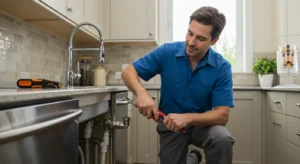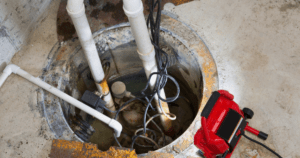Ever turned on the tap only to be greeted by rusty water? You’re not alone. Many homeowners grapple with pipe corrosion, but do you know how it actually works?
This article demystifies the science behind pipe corrosion, exploring contributing factors, types of corrosion, preventative measures, and its impact on your plumbing system.
Let’s delve into this ‘rusty’ problem together!
Understanding the Science Behind Pipe Corrosion
Let’s dive into understanding the science behind pipe corrosion. It’s not as complicated as you might think.
At its core is basic Corrosion Chemistry. It starts when metal comes into contact with water and oxygen– a reaction that creates iron oxide or ‘rust’.
Material Vulnerability plays a significant role too; certain materials are more susceptible to corrosion than others, such as iron and steel.
But don’t fret! There’re ways to prevent this. Coating your pipes with protective layers of paint or using cathodic protection can help slow down the process significantly.
Understanding how pipe corrosion works isn’t just useful—it’s essential in maintaining your home and preventing costly repairs down the line.
So keep learning, stay aware, and protect your pipes!
Factors Contributing to Pipe Corrosion
There are several factors that can contribute to the deterioration of your plumbing systems. These include water chemistry, temperature, and flow rate. The climate you live in also plays a significant role. Harsh winters or scorching summers can exacerbate wear and tear. Additionally, where you live can affect corrosion rates due to variations in soil composition.
Corrosion costs should not be underestimated. They may start small, but if left unchecked, they can quickly escalate. The cost is not just financial. Damaged pipes can lead to health risks from contaminated water or structural damage from leaks.
It is important to remember that prevention is better than cure. Regular inspections can help identify potential issues early on. This way, you won’t be caught off guard by sudden pipe failures and unexpected expenses down the line.
Different Types of Pipe Corrosion
You’ll find that various types of deterioration can affect your plumbing systems, each with its unique causes and effects. Understanding these can help you select corrosion-resistant materials and employ efficient corrosion detection methods.
Here are five common types of pipe corrosion:
- Uniform Corrosion: The entire surface corrodes at the same rate.
- Galvanic Corrosion: Occurs when two dissimilar metals are in contact.
- Crevice Corrosion: Happens in stagnant areas where oxygen is limited.
- Pitting Corrosion: Small, deep holes form on the metal’s surface.
- Intergranular Corrosion: The grain boundaries of a material corrode faster than its bulk.
Each type requires different prevention strategies. Stay proactive to avoid potential damages!
Prevention and Control Measures for Pipe Corrosion
It’s crucial to implement preventive measures and control strategies to combat the deterioration of your plumbing systems. One such strategy involves the use of corrosion resistant materials. These are specially designed materials that can withstand corrosive elements, effectively enhancing the longevity of your pipes.
Another approach you should consider is leveraging coating technologies. This entails applying a protective layer onto your pipes which serves as a barrier against corrosive agents. The coating further reduces the rate at which corrosion occurs, thereby preserving your plumbing system.
The Impact of Pipe Corrosion on Plumbing Systems
Plumbing systems can take a real hit from the adverse effects of deteriorating materials. Pipe corrosion, specifically, is a major offender that you shouldn’t underestimate. It’s not just about the visible damage; it’s also about the hidden corrosion costs. These can eat into your finances like nothing else – think repairs, replacements, and even potential water damage.
And let’s not forget corrosion-related accidents. A weakened pipe could burst unexpectedly, flooding your property or causing severe structural issues. You’re then left with a hefty repair bill that you weren’t prepared for.
So don’t shrug off those early signs of pipe corrosion; they’re more than just an inconvenience – they’re a ticking time bomb in your plumbing system.
Frequently Asked Questions
Q: How Long Does It Typically Take for Corrosion to Cause Significant Damage to Pipes?
A: It’s hard to pinpoint an exact timeline for corrosion damage, as it depends on various factors. However, without proper corrosion prevention methods, significant pipe damage can occur within a few years, impacting your finances.
Q: Is Pipe Corrosion More Common in Certain Geographical Locations?
A: Yes, pipe corrosion can be more common in certain locations. Coastal areas with salty air or places with high humidity levels can speed up the process. Proper material selection and corrosion prevention are crucial.
Q: Does Pipe Corrosion Pose Any Health Risks to Humans?
A: Sure, pipe corrosion can pose health risks. It’s staggering to learn that over 10 million U.S households are affected. Corrosion prevention and material alternatives are crucial for reducing these risks to you and your family.
Q: Are There Any Specific Industries That Are More Prone to Experiencing Pipe Corrosion?
A: Yes, industries like oil and gas, water treatment, and maritime are more prone to pipe corrosion. Corrosion prevention is key through material selection that’s resistant to the specific environment’s corrosive elements.
Q: Can Pipe Corrosion Lead to Other Structural Damages Beyond the Plumbing System?
A: Yes, pipe corrosion can definitely cause further structural damage. It’s not just your plumbing at risk. Material selection and corrosion prevention are key to protect the integrity of surrounding structures too.
Read More: Should I Call a Plumber if My Toilet Keeps Filling Up with Water?
Conclusion
Think of your pipes as a fortress. If left unguarded, invaders like rust and corrosion can breach its walls. You hold the power to fortify these defenses with knowledge of corrosion types, contributing factors, and control measures.
Don’t let your plumbing system fall victim to this silent destroyer. So, gear up! Be proactive in preventing pipe corrosion and keep your fortress strong and intact.







